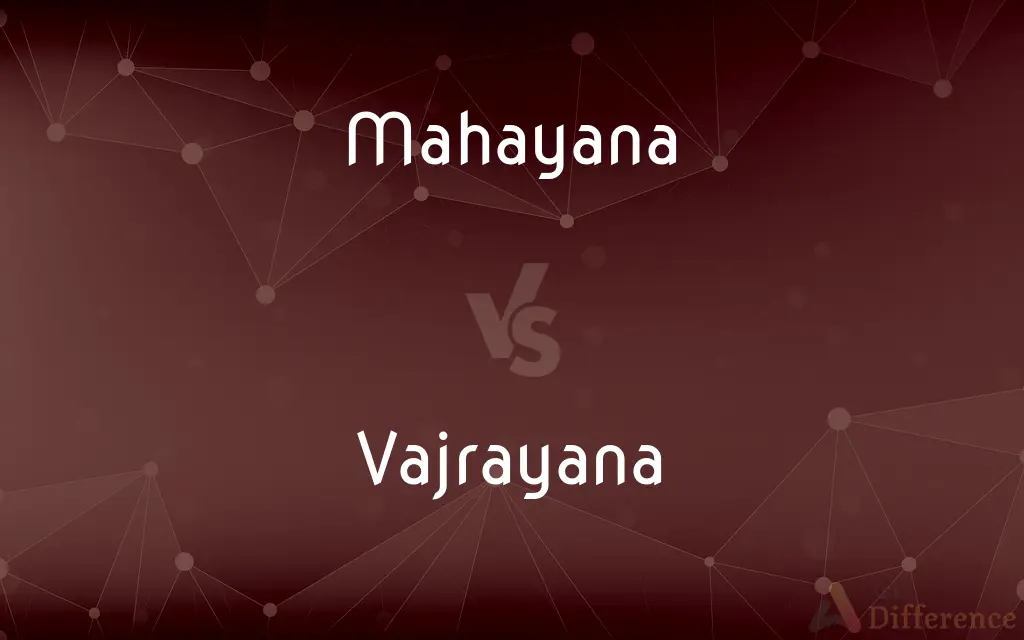Mahayana vs. Vajrayana — What's the Difference?
By Fiza Rafique & Maham Liaqat — Updated on March 20, 2024
Mahayana Buddhism emphasizes the path of the Bodhisattva and universal compassion, while Vajrayana, a subset of Mahayana, incorporates esoteric rituals and tantra to achieve enlightenment rapidly.

Difference Between Mahayana and Vajrayana
Table of Contents
ADVERTISEMENT
Key Differences
Mahayana Buddhism is known for its inclusivity and the ideal of the Bodhisattva, a being who seeks enlightenment not just for themselves but for all sentient beings. Whereas Vajrayana Buddhism, which emerged within Mahayana, adopts more esoteric practices and rituals, aiming to accelerate the path to enlightenment by harnessing innate enlightened energies.
Mahayana's philosophical foundation includes the concept of emptiness and the interconnectedness of all things, promoting a universal compassion. On the other hand, Vajrayana introduces advanced techniques like deity yoga and mantra recitation, believing these methods can lead to a more direct experience of enlightenment.
While Mahayana Buddhism is widespread across East Asia, including countries like China, Japan, and Korea, Vajrayana is primarily practiced in the Himalayan regions, such as Tibet, Bhutan, and parts of Nepal and Mongolia. This geographical distinction also influences the cultural expressions of these traditions.
Mahayana teachings often focus on the expansive collection of sutras and emphasize philosophical understanding and compassion. Vajrayana, however, places a significant emphasis on the guru-disciple relationship, considering the guidance of a realized teacher essential for navigating its complex practices.
The practice of Mahayana involves meditation, mindfulness, and ethical living as paths to awaken one's Buddha nature. Vajrayana adds to this foundation with esoteric practices such as visualizations, intricate rituals, and the use of mandalas, believed to transform ordinary experiences into opportunities for spiritual growth.
ADVERTISEMENT
Comparison Chart
Ideal
Bodhisattva path, seeking enlightenment for all beings.
Rapid enlightenment using esoteric techniques.
Practices
Meditation, mindfulness, ethical living.
Deity yoga, mantras, tantra, guru devotion.
Philosophical Foundations
Emptiness, interdependence, universal compassion.
Adds tantra, deity yoga, and esoteric rituals to Mahayana foundations.
Geographical Distribution
East Asia (China, Japan, Korea).
Himalayan regions (Tibet, Bhutan, Nepal, Mongolia).
Cultural Expression
Diverse, influenced by local cultures.
Highly ritualistic, with unique art forms like thangkas and sand mandalas.
Compare with Definitions
Mahayana
Universal path to enlightenment.
Mahayana Buddhism focuses on achieving enlightenment for the benefit of all beings.
Vajrayana
Guru devotion.
The relationship with a spiritual guru is central to Vajrayana practice.
Mahayana
Emphasis on compassion.
The heart of Mahayana practice is compassion and the wish to alleviate others' suffering.
Vajrayana
Deity yoga.
Practitioners of Vajrayana visualize themselves as deities to embody enlightened qualities.
Mahayana
Bodhisattva ideal.
In Mahayana, the Bodhisattva vows to postpone nirvana until all beings are liberated.
Vajrayana
Esoteric practices.
Vajrayana Buddhism uses specialized rituals and mantras to accelerate enlightenment.
Mahayana
Diverse teachings.
Mahayana encompasses a wide range of teachings, including the Heart Sutra and the Lotus Sutra.
Vajrayana
Rapid path to enlightenment.
Vajrayana is sometimes called the Diamond Vehicle for its direct approach to enlightenment.
Mahayana
Philosophical depth.
Mahayana explores deep philosophical concepts like emptiness and interdependent origination.
Vajrayana
Ritualistic complexity.
Vajrayana rituals often involve intricate ceremonies and the use of sacred objects.
Mahayana
Mahāyāna (; "Great Vehicle") is a term for a broad group of Buddhist traditions, texts, philosophies, and practices. Mahāyāna Buddhism developed in India (c.
Vajrayana
Vajrayāna (Sanskrit: "thunderbolt vehicle" or "diamond vehicle") along with Mantrayāna, Guhyamantrayāna, Tantrayāna, Tantric Buddhism and Esoteric Buddhism are names referring to Buddhist traditions associated with Tantra and "Secret Mantra", which developed in the medieval Indian subcontinent and spread to Tibet, East Asia, Mongolia and other Himalayan states. Vajrayāna practices are connected to specific lineages in Buddhism, through the teachings of lineage holders.
Mahayana
One of the major schools of Buddhism, traditionally active in much of Nepal, Tibet, and East Asia and emphasizing compassion and the possibility of universal salvation.
Vajrayana
One of the major schools of Buddhism, active especially in Tibet and Japan and emphasizing esoteric teachings and tantric practices as a means to enlightenment.
Mahayana
A major school of Buddhism teaching social concern and universal salvation, found in China; Japan; Tibet; Nepal; Korea; and Mongolia.
Mahayana
One of two great schools of Buddhist doctrine emphasizing a common search for universal salvation esp through faith alone; chiefly in China; Tibet; Japan.
Mahayana
A major school of Buddhism teaching social concern and universal salvation; China; Japan; Tibet; Nepal; Korea; Mongolia
Mahayana
One of two great schools of Buddhist doctrine emphasizing a common search for universal salvation especially through faith alone; the dominant religion of China and Tibet and Japan
Common Curiosities
Why is the Bodhisattva ideal important in Mahayana?
The Bodhisattva ideal embodies selfless compassion, aspiring to attain enlightenment for the sake of all beings.
What role does the guru play in Vajrayana?
In Vajrayana, the guru is essential for transmitting teachings, initiations, and guiding the practitioner's spiritual journey.
Is Vajrayana a separate school from Mahayana?
Vajrayana is considered a subset of Mahayana, building upon its foundational teachings with additional esoteric practices.
How do Mahayana and Vajrayana view the concept of emptiness?
Both traditions embrace emptiness, but Vajrayana further utilizes this understanding in its tantric practices to transform ordinary perceptions.
What distinguishes Mahayana from Vajrayana Buddhism?
Mahayana emphasizes universal enlightenment and compassion, while Vajrayana incorporates esoteric practices for a rapid path to enlightenment.
Can anyone practice Vajrayana Buddhism?
Vajrayana practices often require initiation and guidance from a qualified guru due to their complexity.
Are there different meditation practices in Mahayana and Vajrayana?
While both include meditation, Vajrayana adds advanced techniques like deity yoga and visualizations.
What is the significance of mandalas in Vajrayana?
Mandalas represent the universe and serve as a meditative tool for envisioning the pure land of a deity.
Can Vajrayana be found outside of the Himalayan regions?
Yes, due to global interest and the diaspora of Tibetan communities, Vajrayana has followers worldwide.
How do the ethical teachings differ between Mahayana and Vajrayana?
Both share a foundation in ethical conduct, but Vajrayana may apply these principles within the context of its more esoteric practices.
How do art and iconography differ between Mahayana and Vajrayana?
Vajrayana is known for its rich, symbolic art, including thangkas and mandalas, which are used as aids in meditation and ritual.
How do Mahayana and Vajrayana Buddhists view the nature of reality?
Both view reality as ultimately empty of inherent existence but Vajrayana employs this understanding in its tantric practices for transformation.
What is the role of compassion in Mahayana and Vajrayana?
Compassion is central to both; in Mahayana as a philosophical cornerstone, and in Vajrayana as a key element in tantric practices.
How do practitioners of Mahayana and Vajrayana approach the concept of enlightenment?
Mahayana practitioners aspire to enlightenment for all beings, while Vajrayana practitioners use specific techniques to achieve enlightenment rapidly, also for the benefit of others.
What is the significance of mantras in Vajrayana?
Mantras are considered powerful tools for transformation and invoking enlightened energies in Vajrayana.
Share Your Discovery

Previous Comparison
Support vs. Sustenance
Next Comparison
Parfit vs. ParfaitAuthor Spotlight
Written by
Fiza RafiqueFiza Rafique is a skilled content writer at AskDifference.com, where she meticulously refines and enhances written pieces. Drawing from her vast editorial expertise, Fiza ensures clarity, accuracy, and precision in every article. Passionate about language, she continually seeks to elevate the quality of content for readers worldwide.
Co-written by
Maham Liaqat














































